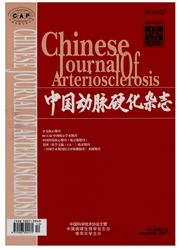

 中文摘要:
中文摘要:
目的观察糖基化终末产物对体外培养的血管平滑肌细胞钙化的影响。方法在含10 mmol/Lβ-甘油磷酸钠培养液中加入不同浓度(0、50、100、200 mg/L和400 mg/L)的糖基化终末产物与大鼠血管平滑肌细胞孵育不同时间。采用磷酸苯二钠法检测碱性磷酸酶活性,甲-酚酞络合酮方法测定钙含量,实时定量逆转录聚合酶链反应检测成骨细胞特异性核心结合因子、碱性磷酸酶以及骨桥蛋白基因表达,蛋白免疫印迹检测成骨细胞特异性核心结合因子及骨桥蛋白蛋白表达。结果与对照组相比,糖基化终末产物随作用时间延长和浓度增加,细胞钙含量增加(P〈0.05),升高碱性磷酸酶活性和基因表达(P〈0.05),促进成骨细胞特异性核心结合因子及骨桥蛋白基因及蛋白表达(P〈0.01)。结论糖基化终末产物可促进体外培养的大鼠血管平滑肌细胞钙化。
 英文摘要:
英文摘要:
Aim To investigate the effects of advanced glycation end products(AGE) on calcification in cultured rat aortic vascular smooth muscle cells(VSMC). Methods To induce calcification,VSMC were treated with 10 mmol/L β-glycerophosphate(β-GP) with the indicated concentrations of AGE-BSA or non-glycated BSA for various periods of time.Calcium deposition,the activity and mRNA expression of alkaline phosphatase(ALP),as well as core band factor α-1(Cbfα-1) and osteopontin(OPN) were used to identify osteoblastic differentiation and mineralization in VSMC induced by AGE-BSA. Results AGE increased calcium deposition in VSMC in time-and dose-dependent manners.Mechanistic studies revealed that elevated AGE treatment of VSMC enhanced the activity and mRNA of alkaline phosphatase,as well as the expression of Cbfα-1 and its downstream protein osteopontin. Conclusion The results suggest that AGE accumulated in diabetes could elicit the osteoblastic differentiation of VSMC,thereby contributing to vascularcalcification.
 同期刊论文项目
同期刊论文项目
 同项目期刊论文
同项目期刊论文
 期刊信息
期刊信息
